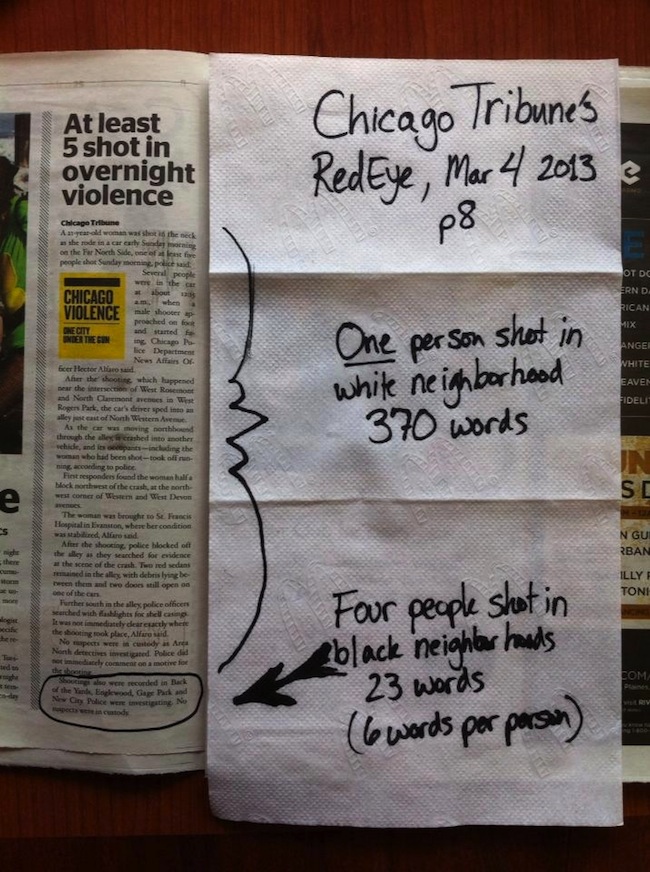Is the Chicago Tribune’s RedEye paper racist?
IS the Chicago Tribune’s RedEye paper racist? No.
On Facebook we spotted the news that the paper used 300 words to report on a shooting in a “white” part of Chicago but just 20 words top tell the story of four shootings in “black” neighbourhoods.
Racist?
The story is a short version of an article in the Chicago Tribune. It’s not racist. It’s just expedient.
The RedEye is targeted at commuters on the El, many of whom ride downtown from the north side, so it would make sense to put the focus of a crime story on that neighborhood, which I understand is more ethnically diverse and gentrifying than “white.” I would also note that the races of the subjects of the story are not identified.
In my experience, there are reasons that crime in poor neighborhoods sometimes gets short shrift that are related to race, but racism among journalists is not one of them.
A middle class person simply has more of a “paper trail” and is more likely to get more space in the paper for a host of reasons: they’ve been mentioned in the news before; they have things like Facebook pages; their relatives are more likely to have land line phones and thus be listed in the phone book; they may have professional licenses or voter registration records; and they likely have a credit record, so they show up in databases like Nexis.
In short: the journalist is lazy?
Factually inaccurate, easily impeached, and ideologically-driven agitprop is still factually inaccurate, easily impeached, and ideologically-driven agitprop however many times it’s shared on the web.Not only is the paper in question not a “paper of record” but, rather, a freebie full of social life and celebrity stories handed out at “L” stations to push tanning salon and nightclub promotions onto the young demographic it targets, with a few truncated stories from the Tribune (its publisher) thrown in to make it seem just a tad more “newsy,” but the “info” on the napkin is also completely inaccurate.
Not only is the neighborhood in question not at all a “white neighborhood,” but , although the napkin makes no such claims, it is somehow implied by the throngs of people sharing the photo that the victim was also white when not only was this never revealed, it’s very likely to be untrue as well.
At best, the original poster was being intentionally misleading, and has little to no notion of how newspapers actually work. At worst, they were looking to stoke the flames of righteous indignation, with a racial angle, facts be damned, for reasons only they can possibly know.
The truly sad (and scary) thing is that thousands of people have and will continue to see and share it since it validates their own worldview without ever realizing that it’s largely a fiction. Scores of people are viewing it as an indictment of “racist journalism” without bothering to take the time to honor one of journalism’s most important principles and “check it out” themselves.
This sort of rapid sharing of pictures and information has never been easier, or more popular, than it has been in the age of social media. As long as you agree with a given worldview, or ideology, I suppose this might not be terribly troubling. Human history, however, is rife with half-truths and lies being spread like wildfire only to see real human lives caught up in, and destroyed, by those flames.
“The notion that journalists in a major metro’s newsroom would prioritize coverage based on race or socio-economic status is laughable to anyone who has worked in such a place.”
The poster must have worked in heaven. I worked at the Dayton Daily News and the Plain Dealer where editors did exactly that.
At the Dayton Daily News, an editors’ daynote mentioned some “welfare mother” called to say a funeral home wouldn’t handle her child’s body. The story would have died – but I pointed out the “welfare mother” wasn’t on welfare at all; we’d done a story on the child because she was a miracle baby.
In Cleveland, editors routinely ignored inner-city stories because they said the suburban readers wouldn’t care about the subjects or the topics.
But the long letter above makes me wonder? Ha journalism changed so much that reporters don’t go find the facts?
Does the poster really think poor folks aren’t on Facebook? Does the reporter look on Facebook? Does the reporter think Nexis is only limited to middle-class people. Don’t so-called poor people get traffic tickets. And finally – but most importantly – who still uses a phone book?
The finals word is with the paper:
“The online conversation that’s developing around this story is an important one. Thank you for the comments and feedback. This is incredibly important to us, especially as we set out to shine a light on Chicago violence this year. Conversations like these will continue to inform and improve our coverage. We hope you’ll continue to join us in addressing these issues.”
So. When a black child goes missing it will be covered in the same way as when a white child goes missing? It all depends on whose buying your papers…
Posted: 7th, March 2013 | In: Reviews Comment | TrackBack | Permalink



